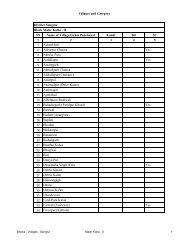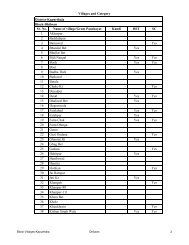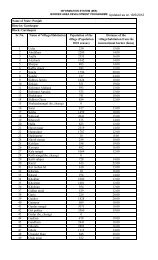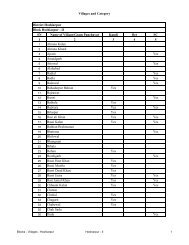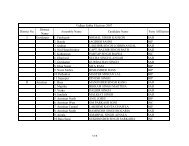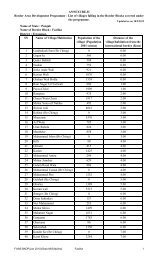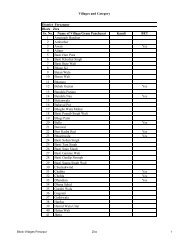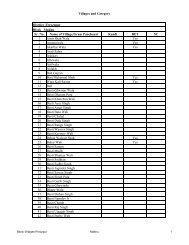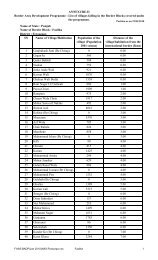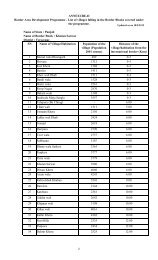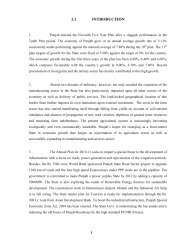Survey for BPL Families - Punjab State Planning Board
Survey for BPL Families - Punjab State Planning Board
Survey for BPL Families - Punjab State Planning Board
Create successful ePaper yourself
Turn your PDF publications into a flip-book with our unique Google optimized e-Paper software.
Sub: <strong>Survey</strong> <strong>for</strong> <strong>BPL</strong> <strong>Families</strong><br />
This brief note explains the modalities followed <strong>for</strong> various <strong>BPL</strong> surveys.<br />
1. <strong>BPL</strong> survey <strong>for</strong> 9 th Plan (1997-2002) (Rural) – Annual family income to be less<br />
than Rs. 20,000 and the families should not have more than 2 hectares of land or TV or<br />
Fridge. The number of rural <strong>BPL</strong> families was 6.5 lakh during the 9 th Plan. The survey<br />
based on this criteria was again carried out in 2002 and the total number of 3.87 lakh<br />
families were identified. This figure was in <strong>for</strong>ced till September, 2006.<br />
2. <strong>BPL</strong> <strong>for</strong> 10 th Plan (2002-07) (Rural) – This survey is based on the degree of<br />
deprivation in respect of 13 para-meters (with scores from 0-4) – land holding, type of<br />
house, clothing, food security, sanitation, consumer durables, literacy status, labour <strong>for</strong>ce,<br />
means of livelihood, status of children, type of indebtedness, reasons <strong>for</strong> migrations etc.<br />
The <strong>Planning</strong> Commission fixed an upper limit of 3.26 lakh <strong>for</strong> rural <strong>BPL</strong> families on the<br />
basis of simple survey. Accordingly families having less than 15 marks out of maximum 52<br />
marks have been classified as <strong>BPL</strong> and their number works out to 3.18 lakh. The survey<br />
was carried out in 2002 and thereafter but could not be finalised due to stay by the SC. The<br />
stay was vacated in February, 2006 and this survey was finalised and adopted in<br />
September, 2006. This survey would <strong>for</strong>m the basis <strong>for</strong> benefits under GoI schemes. The<br />
state government is free to adopt any criteria/survey <strong>for</strong> the state level schemes.<br />
3. 10 th Plan <strong>BPL</strong> <strong>Survey</strong> <strong>for</strong> Urban <strong>Families</strong> – This survey was based on degree of<br />
deprivation in respect of 7 para meters – roof, floor, water, sanitation, education level, type<br />
of employment & status of children in a house. A total of 1.25 lakh upper families were<br />
identified as <strong>BPL</strong> in urban area in 2004. It is under implementation since then.<br />
4. Kerala Government – Most of the state governments followed the 13 and 7 para<br />
meters definition <strong>for</strong> identifying the <strong>BPL</strong> families during the current 10 th Plan. Kerala<br />
Government is one of the few state government which has <strong>for</strong>mulated its own criteria.<br />
There are 9 para meters and if the family does not have access to 4 or more para meters<br />
than it is classified as <strong>BPL</strong>. The 9 para meters <strong>for</strong> urban areas are – No land/Less than 5<br />
cents of land, No house/dilapidated house, No sanitation latrine, Family without colour TV,<br />
1
No regular employed person in the family, No access to safe drinking water, Women<br />
headed house hold/Presence of widow divorcee, Socially disadvantaged groups SC/ST &<br />
Mentally retarded/disabled member in the family. The 9 para meters <strong>for</strong> rural are - No<br />
land/Less than 5 cents of land, No house/dilapidated house, No sanitation latrine, Family<br />
with an illiterate adult member, No regular employed person in the family, No access to<br />
safe drinking water, Women headed house hold/Presence of widow divorcee, Socially<br />
disadvantaged groups SC/ST & Mentally retarded/disabled member in the family.<br />
5. Haryana Government – The <strong>BPL</strong> survey was carried out as per the GoI guidelines<br />
in Haryana and it was based on 13 para meters. The Government has recently dis-carded it<br />
and adopted new 5 para-meters based survey. The 5 points are – land, house, household<br />
goods, literacy level and means of livelihood /standard of living. The survey is to be carried<br />
out by Ex-serviceman who would be paid Rs. 4 per family.<br />
6. Maharashtra Government – The Maharashtra Government has also decided to<br />
conduct fresh <strong>BPL</strong> survey. About 46 lakh <strong>BPL</strong> families were identified on the basis of 13<br />
point criteria. There was lot of resentment and a total of 10.56 lakh appeals were filed<br />
against the survey. In view of this they have decided to discard the survey and conduct<br />
fresh survey.<br />
7. International Scene – Income of less than $ 1 per day per head (purchasing power<br />
parity) is defined as extreme poverty. As per these estimates about 45% of Indian<br />
Population is extremely poor. If the daily income per head is $ 2 then the family is<br />
described as poor and about 80% of Indian Population is poor by this criteria.<br />
The poverty line in United <strong>State</strong>s is fixed in terms of annual family income. Originally<br />
in 1969 the requirements of family in terms of food were worked out with reference to 1963<br />
prices. It was found that a family of 4 would require $ 1033 per annum <strong>for</strong> meeting the food<br />
requirement. The study revealed that families in that income spent nearly 1/3 rd income on<br />
food and there<strong>for</strong>e the poverty line <strong>for</strong> family of 4 was fixed as $ 3099 per annum. The<br />
poverty line is revised annually after taking inflation into account. For the year 2006 it was $<br />
20650 per annum per family (comprising 4 members).<br />
2
8. Income based poverty line in India/<strong>Punjab</strong> – The poverty line was originally fixed<br />
in terms of income/food requirements in 1978. It was stipulated that the calorie standard <strong>for</strong><br />
a typical individual in rural areas were 2400 calorie and was 2100 calorie in urban areas.<br />
Then the cost of the grains (about 650 gms) that fulfill this normative standard was<br />
calculated. This cost was the poverty line. In 1978, it was Rs. 61.80 per person per month<br />
<strong>for</strong> rural areas and Rs. 71.30 <strong>for</strong> urban areas. Since then the <strong>Planning</strong> Commission<br />
calculates the poverty line every year adjusting <strong>for</strong> inflation. The poverty line in recent years<br />
is as follows -<br />
(Rs. per month per head)<br />
India <strong>Punjab</strong><br />
Year Rural Urban Rural Urban<br />
2000-01 328 454 371.25 400.18<br />
2005-06 368 560 415.80 492.22<br />
These figures are per month per head. This income is bare minimum to support the<br />
food requirements and does not provide much <strong>for</strong> the other basic essential items like<br />
health, education etc. That is why some times the poverty lines have been described as<br />
starvation lines.<br />
9. Fixing Annual Family Income <strong>for</strong> poverty line in <strong>Punjab</strong> - The state government<br />
was considering fixing poverty line in terms of annual family income during the last 2-3<br />
years. The reason was that the 13 para meters survey was started in 2002 but it could not<br />
be finalized due to Supreme Court stay. The Supreme Court vacated the stay on 14/2/2006<br />
and it was decided thereafter that <strong>BPL</strong> survey based on 13 para meters be finalized. It has<br />
accordingly been finalized and details are enclosed herewith.<br />
9.1 Basic Figures – Population and SC <strong>Families</strong><br />
(in lakh)<br />
Total SC <strong>Families</strong><br />
Population <strong>Families</strong>(Average<br />
Family Size)<br />
Population <strong>Families</strong><br />
Rural 160.96 26.59 (6.05) 53.18 8.77 (33%)<br />
3
Urban 82.62 15.52 (5.32) 17.10 3.10 (20%)<br />
Total 243.58 42.11 (5.78) 70.28 11.87 (28%)<br />
Poverty Line <strong>for</strong> the <strong>State</strong> -<br />
o In 2005-06 the poverty line <strong>for</strong> the state as mentioned above was Rs. 415 per month<br />
per head and Rs. 493 per month per head in rural and urban areas respectively.<br />
This works out to Rs. 30,129 and Rs. 31,473 per year per family <strong>for</strong> rural and urban<br />
areas.<br />
o The previous Vice Chairman, <strong>Punjab</strong> <strong>State</strong> <strong>Planning</strong> <strong>Board</strong>, Dr. SS Johl<br />
recommended annual family income <strong>for</strong> <strong>BPL</strong> families as Rs. 45,000. It was worked<br />
out on the basis of minimum wages i.e. Rs. 101 (fixed by <strong>Punjab</strong> Government <strong>for</strong><br />
unskilled labour) <strong>for</strong> 25 days employment in a month <strong>for</strong> 1.5 earning member per<br />
family.<br />
o Guru Nanak Dev University has recommended annual family income of Rs. 50,000<br />
in rural and Rs. 60,000 in urban areas.<br />
o Jaya Mehta in Alternative Economic <strong>Survey</strong> recommended Rs. 775 in rural areas<br />
and Rs. 717 in urban areas per month per head <strong>for</strong> the <strong>Punjab</strong> <strong>State</strong>. These figures<br />
would give annual family income of Rs. 56,000 in rural areas and Rs. 45773 in urban<br />
areas.<br />
o The Centre <strong>for</strong> Policy Alternative has worked out some detailed and scientific<br />
calculation <strong>for</strong> the poverty line. As per their calculation a person would require on an<br />
average every month : Food – Rs. 573, Health – Rs. 30, Clothing – Rs. 17, Energy<br />
Conservation – Rs. 55 and Misc – Rs. 164 = Total – Rs. 840. The poverty line<br />
should not be less than Rs. 840 per month per head. The average family size is Rs.<br />
5.78 in the state and the annual family income thereafter works out to Rs. 58,262.<br />
o Director Agriculture recommends that one acre of land does not fetch more than Rs.<br />
8,000 annual income. We have earlier fixed a cut off of 5 acres of land <strong>for</strong> <strong>BPL</strong><br />
families. This would work out to Rs. 40,000 per annum.<br />
Existing annual family income <strong>for</strong> <strong>BPL</strong> families after adjusting <strong>for</strong> inflation works out<br />
to Rs. 30,000 in the year 2006. The recommendations vary from Rs. 45,000 to Rs. 60,000<br />
as explained above. It would there<strong>for</strong>e be proper if the annual family income <strong>for</strong> <strong>BPL</strong><br />
families is fixed around Rs. 40,000.<br />
4



